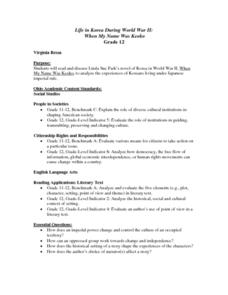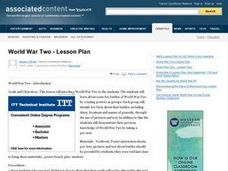Curated OER
The Political Dr. Seuss
High schoolers discuss the role political cartoons have played in U.S. politics and public affairs since the 1700's. They analyze some of the political cartoons Dr. Seuss drew during World War II and discuss how these cartoons conveyed...
Curated OER
5th Grade Social Studies
In this social studies worksheet, 5th graders complete multiple choice questions about immigrants, World War II, the Civil War, prosperity, and more. Students complete 25 questions.
Curated OER
An Untold Triumph
Middle schoolers examine and analyze the history and experience of Filipinos in Hawaii and California. They identify the contributions of Filipino Americans to the US war effort in World War II, and analyze the many causes that led to...
Curated OER
Life in Korea During World War II: When My Name Was Keoko
Twelfth graders review facts about roles of Asia and Japan in World War II, read When My Name Was Keoko to familiarize themselves with daily life and historic events during World War II in Korea, and participate in student-led...
Curated OER
What Did You Do After the War, Grandpa?
Students consider how World War II impacted Europe and European soldiers. In this Victory in Europe lesson, students visit selected websites to discover information about the war, its conditions, and the celebration that ensued at the...
Curated OER
What is to Become of the World After the War?
Students analyze primary sources regarding World War II. In this World War II lesson, students read "The Atlantic Charter," and respond to questions about the document.
Curated OER
Social Changes in America Caused by World War II
Young scholars research and examine the social changes that occured in the United States during World War II. In pairs they conduct research using a variety of resources, and organize and compose a "Guide to Life" for veterans returning...
Curated OER
Lesson Plan on World War II: Illinois Role-The 33rd Infantry Division
High schoolers complete several creative writing assignments regarding the 33rd Infantry Division of Illinois, which was active during World War II. They discuss how this war brought about changes in the state of Illinois and...
Curated OER
Why Were the Japanese Interned During World War II?
Seventh graders analyze sources to determine why Japanese-Americans were placed in internment camps during World War II. They discuss the fact that individual rights are sometimes taken by institutions because of fear and paranoia. They...
Curated OER
Supporting the Searchers: Seaplane Hangers at Norfolk Naval Air Station in World War II
Students examine the reasons for the Allied victory during World War II. They discover the need for air and sea power and where bases are located. They answer questions and discuss answers to complete the lesson.
Curated OER
World War II
Students create a Powerpoint presentation covering key information regarding a World War II battle and present the information to the class in the form of an oral presentation. They then will turn in a summary report including two...
Curated OER
Why Empire? Why War?
Tenth graders examine the purpose of territorial expansion. In this World History lesson, 10th graders analyze various articles on World War II. Students prepare arguments for and against territorial expansion.
Curated OER
What Caused WWII?
In this causes of World War II study guide worksheet, learners read a brief overview pertaining to the time period in world history and then respond to a reflection question.
Curated OER
Introduction to the Early Origins of the Cold War
In this Cold War worksheet, students read a 4-paragraph selection about post World War II diplomacy and then list key dates and events noted in the selection.
Curated OER
My Secret War: Lesson 14
Fifth graders explore the civilian role during World War II. In this social studies lesson, 5th graders write an "I Am an American" poem from the perspective of various Americans during the war.
Curated OER
My Secret War: Lesson 13
Fifth graders explore the effect of World War II on the lives of children in America. In this social studies instructional activity, 5th graders read My Secret War and discuss the events that occurred.
University of California
Decolonization
The ripple effect from one small event can impact many others. Young historians research the ripple effect World War II had on decolonization in the second installment of an eight-part series. Through primary and secondary documents as...
Curated OER
Attu: North American Battleground of World War II
Students examine military maps and photos to better explain why an isolated battle on a remote island in Alaska alarmed the nation. They explain how the Japanese occupation and American recapture of Attu were significant in the history...
Curated OER
Causes of WWII
In this causes of World War II worksheet, students read key reasons that the war escalated this graphic organizer.
Smithsonian Institution
The Price of Freedom: Americans at War
An interactive resource covers all of the United States' most prominent and influential historic wars including the Vietnam War, the Cold War, the War of 1812, and the Korean War. Learners observe cause and effect as well as how violence...
Curated OER
Events of World War II
Ninth graders examine the main leaders and events of World War II. In small groups they analyze images of main events in WWII, listen to a lecture, and complete a fill-in-the-blank worksheet.
Curated OER
Evaluate Causes of U.S. Involvement in World War II
Students examine and evaluate causes of U.S. involvement in World War II by interpreting a telegram from General Douglas MacArthur to William Allen White, the publisher and editor of Kansas' Emporia Gazette.
Curated OER
Graphic Organizer: Holocaust
Help your class process and organize what they've learned about World War II and the Holocaust with a graphic organizer. There are four boxes on this page, two over the word Holocaust and two under. The two on top require learners to...
Curated OER
Main Causes of World War Two
In this causes of World War II study guide learning exercise, learners discover details regarding this time period in world history. Students read 13 sections of information and examine photographs.

























